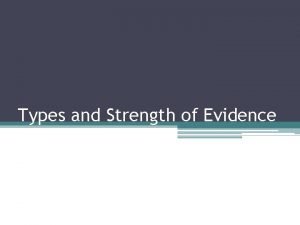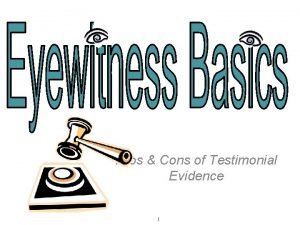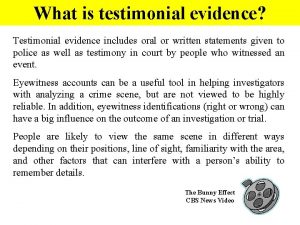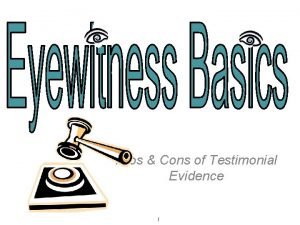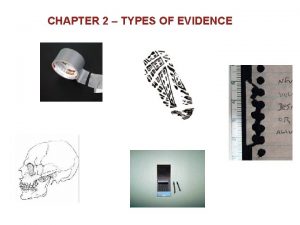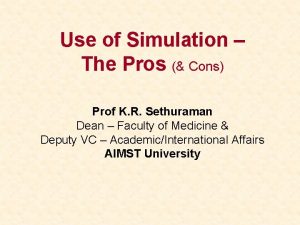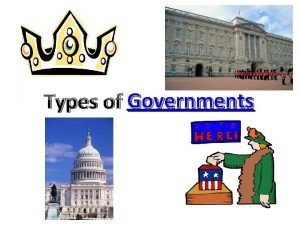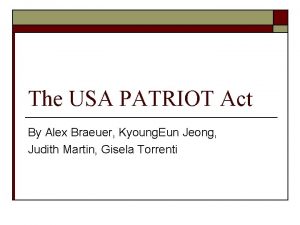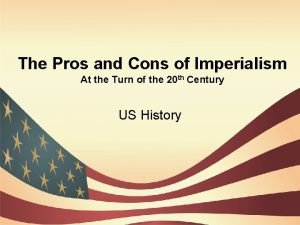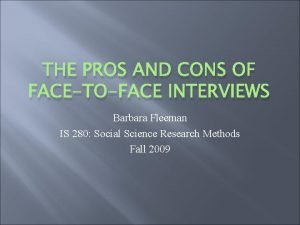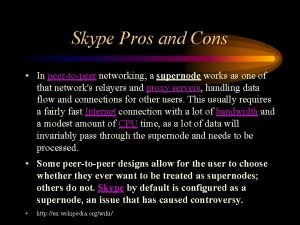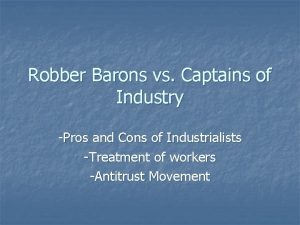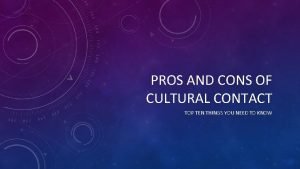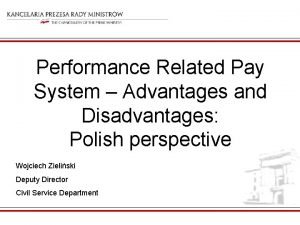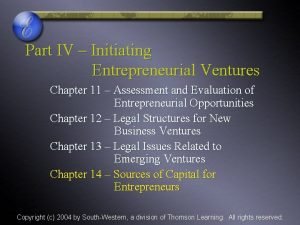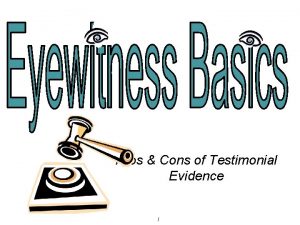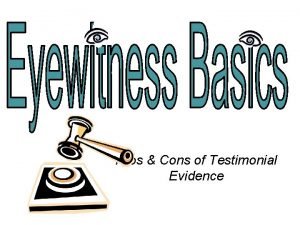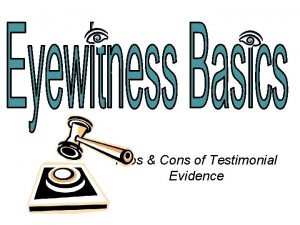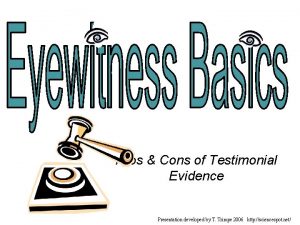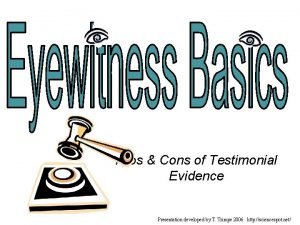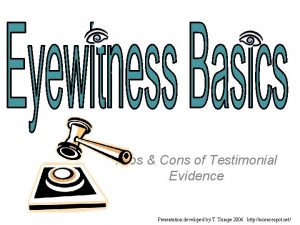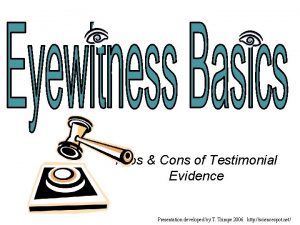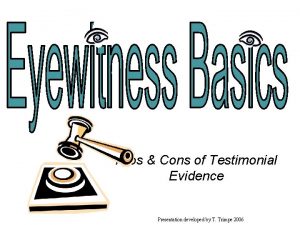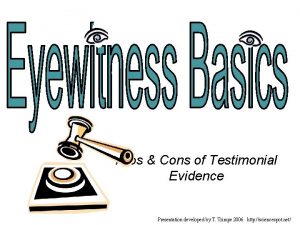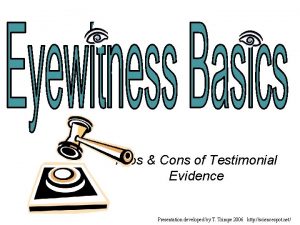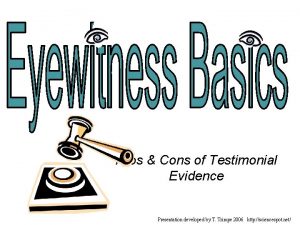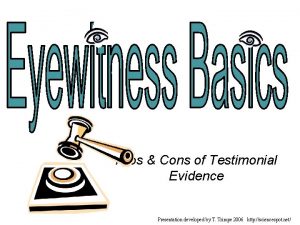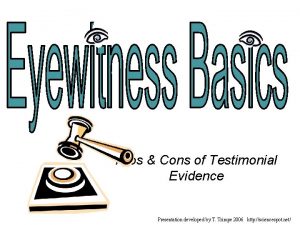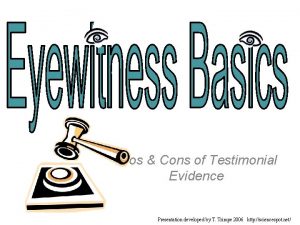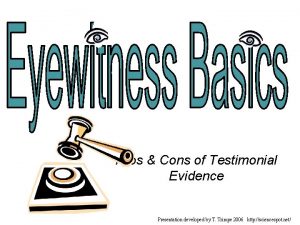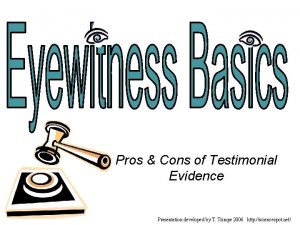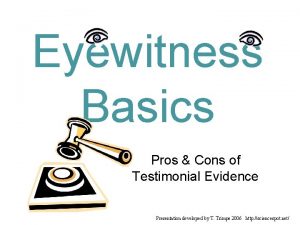Pros Cons of Testimonial Evidence Do Now Have
























































- Slides: 56

Pros & Cons of Testimonial Evidence

Do Now Have you ever been to Disneyland? If so do you remember seeing/meeting any of the following characters? Write down all the characters you remember meeting and what they were doing. • • • Cinderella? Mickey Mouse? The Little Mermaid? Bugs Bunny? Sleeping Beauty? http: //vimeo. com/45086587

The Bunny effect • http: //vimeo. com/45086587 • She and colleagues were able to get subjects to "remember" seeing Bugs Bunny at Disneyland. . . even though that's not possible. Bugs Bunny is a Warner Brothers cartoon.

What is testimonial evidence? • Testimonial evidence includes oral or written statements given to police as well as testimony in court by eyewitnesses. • Eyewitness accounts can be a useful tool in helping investigators with analyzing a crime scene, but are not highly reliable. • Eyewitness identifications (right or wrong) can have a big influence on the outcome of an investigation or trial. • People view the same scene in different ways depending on their positions, line of sight, familiarity with the area, and other factors that can interfere with a person’s ability to remember details.

Memory Challenge Directions: You will have 30 seconds to view the next screen. Try to memorize all 20 items you see! You are NOT allowed to write anything down You CANNOT talk to anyone!

Items to remember. . .

What do you remember? You have 2 minutes to list as many of the items as you can! How did you do? All 20 – Awesome 15 -19 – Great 10 -14 – Pretty swell 5 -9 – Could be better 4 or Less – Wake up

Did you know? According to The Innocence Project (2008) "Eyewitness misidentification is the single greatest cause of wrongful convictions nationwide, playing a role in more than 75% of convictions overturned through DNA testing. " Still, the criminal justice system profoundly relies on eyewitness identification and testimony for investigating and prosecuting crimes (Wells & Olson, 2003). What are some factors that may affect a person’s memory and their ability to identify a suspect?

Factors that May Influence Eyewitness Accounts 1. Age: When a lineup contains the actual suspect, young children and elderly perform well, but when the lineup does not contain the suspect, there is a higher rate of mistaken identifications. Q. Elaborate this point by explaining the implications (what is suggested) of mistaken identifications.

Factors that May Influence Eyewitness Accounts 1. Age: When a lineup contains the actual suspect, young children and elderly perform well, but when the lineup does not contain the suspect, there is a higher rate of mistaken identifications. Justify this point in your own words.

Factors that May Influence Eyewitness Accounts 2. Race: The Cross Race Effect (CRE)-People are better at recognizing faces of their own race rather than those of other races. Q. Do you agree with this statement? Justify your answer.

Factors that May Influence Eyewitness Accounts 2. Race: The Cross Race Effect (CRE)-People are better at recognizing faces of their own race rather than those of other races. Q. What would you suggest should be done to rectify the CRE during a line-up?

Factors that May Influence Eyewitness Accounts 3. Drugs: The use of drugs can alter a person’s ability to recall the events of a crime even after they are no longer under the influence. Q. “…Even after they are no longer under the influence. ” What is being implied here?

Factors that May Influence Eyewitness Accounts 3. Drugs: The use of drugs can alter a person’s ability to recall the events of a crime even after they are no longer under the influence. Q. “…Even after they are no longer under the influence. ” What is being implied here?

Factors that May Influence Eyewitness Accounts 4. Contamination: A person’s memory of an event can be influenced by other witnesses, investigators, and/or the media. Investigators use open-ended questioning and follow procedures for conducting lineups to limit their influence on a witness’ memory of an event or identification of a suspect. What is an open-ended question?

Factors that May Influence Eyewitness Accounts 1. Age: When a lineup contains the actual suspect, young children and elderly perform well, but when the lineup does not contain the suspect, there is a higher rate of mistaken identifications. 2. Race: The Cross Race Effect (CRE)-People are better at recognizing faces of their own race rather than those of other races. 3. Drugs: The use of drugs can alter a person’s ability to recall the events of a crime even after they are no longer under the influence. 4. Contamination: A person’s memory of an event can be influenced by other witnesses, investigators, and/or the media. Investigators use open-ended questioning and follow procedures for conducting line-ups to limit their influence on a witness’ memory of an event or identification of a suspect. What is an open-ended question?

Factors that May Influence Eyewitness Accounts 5. Circumstances: A crime that is extremely traumatic may affect eyewitness recall of the event. Ex. A witness confronted with a weapon tends to focus on the weapon rather than the perpetrator’s face. 6. Time: Someone who is able to focus on a perpetrator's face for a minute or more will have a more accurate memory than someone who saw the person for only a few seconds. 7. Face: Highly attractive, highly unattractive, or distinctive faces (i. e. , body piercings and tattoos) are more likely to be accurately recognized. Simple disguises, such as hats or sunglasses, can interfere with accurate eyewitness identification. 8. Location & Time of Day: The time of day in which the crime occurred as well as a person’s view of the scene may affect what a he/she is able to see. A person who is familiar with the area, has a better recall of the positions of the victims or suspects.

• A police lineup or identity parade is a process by which a crime victim or witness's identification of a suspect is confirmed to a level that can count as evidence at trial. • The suspect, along with several "fillers" or "foils"—people of similar height, build, and complexion who may be prisoners, actors or volunteers—stand side-by-side, both facing and in profile. • The lineup sometimes takes place in a room with a one-way mirror to allow a witness to remain anonymous, and may include markings on the wall to aid identifying the person's height. • For evidence from a lineup to be admissible in court, the lineup itself must be conducted fairly. The police may not say or do anything that persuades the witness to identify the suspect that they prefer. Police Lineup • . Why do you think this lineup may be inappropriate?

Sequential vs Simultaneous Lineups • Sequential lineup-The • Simultaneous lineup-The suspects or their photos are suspects or photos are presented one at a time to the presented in a group witnesses for only once. (commonly six or nine). Witnesses make decisions People engage in absolute about each individual suspect judgment during sequential before the next one is shown lineups. and they do not know the total number of suspects. • Which lineup Is better?

• Rationale for Change to Blind Sequential Lineups • The most widely used law enforcement eyewitness identification procedure nationwide has long been the simultaneous photo array. • The typical photo array contains six photos. It is common practice for an investigator with knowledge of the case, and the identity of the suspect, to show the photo lineup to witnesses. • Do you think it’s a good idea?

Remember this person!

Which picture is she? Simultaneous lineup and Relative judgment

Remember this Person!

Sequential Lineup





This is the person

• However, 25 years of scientific research on memory and interview techniques convincingly demonstrates that the likelihood of mistaken identification drops sharply if lineups are blind (that is, conducted by someone who does not know who the suspect is) and sequential. • When (as occurred in the DNA exoneration cases), the real perpetrator’s photo is not present in the lineup, witnesses shown the photos simultaneously are up to three times more likely to identify someone than are witnesses shown the same photos sequentially.

• When the real perpetrator’s photo is • included in the lineup, laboratory studies show some reduction in the number of correct identifications made using the sequential method. • However, that somewhat lower identification rate is offset by the much larger risk of misidentification using the simultaneous method if the perpetrator is not present

http: //www. innocenceproject. org/Content/Kenny_Waters. php Over 300 American men and women wrongly convicted of crimes have been exonerated by DNA testing. The bulk of those convictions were based in part on faulty eyewitness identifications. Witnesses are often asked to identify suspects from photo lineups, which are typically conducted by the officers investigating a crime. But these witnesses can be influenced, intentionally or not, by the person conducting a lineup. An officer who believes one of the people in a photo lineup is the likely the perpetrator can influence the proceeding. This has led scientists to recommend “blind” lineups, meaning that the officer who conducts the lineup shouldn’t be aware of the identity of the suspect, so that he or she can’t contaminate the identification procedure. Kenny Waters served 18 years in prison for murder he didn’t commit before DNA testing proved his innocence. His sister, Betty Anne Waters, put herself through college and law school in order to help with her brother’s case. She worked with the Innocence Project to bring about his exoneration in 2001. Sadly, Waters passed away six months after his release. He was 47 years old and had spent more than a third of his life in prison for a crime he didn’t commit. Waters’ case is the focus of the film “Conviction, ” which was released in October 2010.

Innocence Project There have been 317 post-conviction DNA exonerations in United States history. More and more innocent people gain their freedom through post-conviction testing. Our system, however, is not righting itself. WHY are so many innocent people wrongfully convicted? 1. Global problems like poverty and racial issues 2. Criminal justice issues like eyewitness misidentification, invalid or improper forensic science, overzealous police and prosecutors and inept defense counsel SOME STATISTICS: • The average sentence served by DNA exonerees is 13. 6 years. • 70 percent of those exonerated by DNA testing are members of minority groups. • In 50 percent of DNA exoneration cases, the actual perpetrator has been identified by DNA testing. • Exonerations have been won in 38 states and Washington D. C. • 18 people were sentenced to death before DNA exonerated them

DNA Exonerations by year in the US

Incarcerations Statistics If you look at males aged 25 -29 and by race, as of June 30, 2006: For White males ages 25 -29: 1, 685 per 100, 000 (1. 7%). For Latino males ages 25 -29: 3, 912 per 100, 000 (3. 9%). For Black males ages 25 -29: 11, 695 per 100, 000. (That's 11. 7% of Black men in their late 20 s. ) • Calculate the percentages • How are these percentages different in the chart on the right? Why?

The Results: White =0. 4%, Latino = 1%, Black = 2. 2% • For white males: 380 out of 100, 000 = 0. 38% • For Latino males: 966 out of 100, 000 = 0. 97% • For black males: 2207 out of 100, 000 = 2. 21% • Overall, the average rate of incarceration in the US is about 1%.

AIM: What are your Miranda Rights and how did they develop historically? • Do Now: Miranda Rights: read passage annotate by underlining all new information, and answer the following questions: • What rights do the Fifth and Sixth Amendments protect? • What happens to your statement in court when the police fail to “Mirandize” you while in custody? • What is the most valuable bit of information you learned from this short passage?

The Antonio Beaver Case • Questions: • As you are reading this case, describe all of the problems which undermine the credibility of the eyewitness, whose sole testimony may have led to the wrongful conviction of this individual. • What were some of the problems associated with Antonio Beaver’s conviction? How did law enforcement agent misconduct lead to the arrest and wrongful conviction of this individual?

Antonio Beaver Incident Date: 8/15/96 • • • Antonio Beaver Incident Date: 8/15/96 Jurisdiction: MO Charge: First-Degree Robbery Conviction: First-Degree Robbery Sentence: 18 Years Year of Conviction: 1997 Exoneration Date: 3/29/07 Sentence Served: 10 Years Real perpetrator found? Yes Contributing Causes: Eyewitness Misidentification Compensation? Yes

The Crime • On August 15, 1996, a 26 -year-old white woman drove into a St. Louis parking lot planning to park her car and return to work. She approached a man in the lot, thinking he was the parking attendant. The man told her that she had to move her car immediately or it would be towed, and he followed her back to the car. As she got in the car to leave, the man told her she could stay. As she got back out, the man attacked her with a screwdriver and told her to give him the keys and her purse. She struggled with him and then decided to flee; she threw her purse on the seat and jumped out of the car. As she was exiting the car, she noticed that the man was bleeding and that there was blood inside the driver’s side door. She ran into a nearby parking garage and called the police. The victim described her attacker to police as a clean-shaven African. American man wearing a baseball cap. She said the man was 5’ 10’’ tall, with a “David-Letterman-like” gap between his teeth. The next day, the victim helped police draw a composite sketch of the attacker and police recovered the victim’s car in East St. Louis. Latent fingerprints and swabs of the blood stain inside the driver’s side door were collected.

LINE UP ID Six days later, a detective arrested Antonio Beaver because he thought Beaver resembled the composite sketch in this case. However, Beaver had a full mustache, was 6’ 2’’ tall and had chipped teeth. The same detective then prepared a live lineup including Beaver and three other men – two of them police officers. Beaver and the other non-officers were the only two to wear baseball caps, and Beaver was the only one with noticeable defects to his teeth. The victim identified Beaver.

• http: //www. nij. gov/topics/lawenforcement/investigations/eyewitnessidentification/pages/simultaneoussequential. aspx

The Trial Beaver was charged with first-degree robbery and tried in April 1997. The victim testified that Beaver was the man who. attacked her, the prosecution argued that the victim’s clear memory of the crime meant that she was better able to identify the perpetrator. The defense presented evidence showing that fingerprints collected from the victim’s car – including prints from the driver’s side and the rearview mirror – did not match the victim or Beaver. They argued that prints left on the rearview mirror indicated that the person who left them must have driven the car. After several hours of deliberations over two days, the jury convicted Beaver of firstdegree robbery. He was sentenced to 18 years in prison.

The Biological Evidence and Exoneration In 2001, Beaver filed a motion on his own behalf requesting DNA testing. The state opposed the motion, but the court granted a hearing on the issue in 2005. The Innocence Project accepted Beaver’s case and filed another brief on his behalf in 2006. The state agreed to testing on the blood swab from inside the car door in October 2006 and the results proved that Beaver could not have committed this crime. The DNA testing not only excluded Beaver as the source of the blood, but led to the identification of another man already incarcerated for other crimes. Beaver was exonerated on March 29, 2007. He was 41 years old at the time of his exoneration and had served more than a decade in prison.

Crime Scene Challenge • Now that your eyes and brain are warmed up, let’s test your observation skills a bit more. • You will have 2 minutes to study the photograph of a crime scene on the next slide. • Try to pay attention to details as you will be asked 10 questions about the crime scene! • You are not allowed to write anything down until after the time is up. • Ready?


Answer each question below. 1. What color coffee mug was in the picture? 2. When was the deadline? Yesterday Blue Red Today 3. What time was on the clock on the wall? Tomorrow 10: 40 11: 05 4. How many sticky notes were on the whiteboard? Four 5. Which of the following was NOT in the picture? Stapler 6. What was the name on the plaque on the desk? Bill 7. What color was the victim's shirt? Black 8. How many plants were in the picture? None Blue On a box Source: http: //forensics. rice. edu/html/picture_begin. html 1: 55 Six Eight Trash Can Brian Printer Carl Red One 9. What was the color of the marker in the desk drawer? 10. Where was the book in the picture? Yellow Two Red In the trash can Blue Green Under the body

Troy Davis: 23 words! • . • “The incident that night was not my fault, I did not have a gun…I did not personally kill your son, father and brother. I am innocent. ”

The Case • Troy Anthony Davis (October 9, 1968 – September 21, 2011) was an American man convicted of and executed for the August 19, 1989, murder of police officer Mark Mac. Phail in Savannah, Georgia. Mac. Phail was working as a security guard at a Burger King restaurant when he intervened to defend a man being assaulted in a nearby parking lot. During Davis's 1991 trial, seven witnesses testified they had seen Davis shoot Mac. Phail, and two others testified Davis had confessed the murder to them. • Although the murder weapon was not recovered, ballistic evidence presented at trial linked bullets recovered at or near the scene to those at another shooting in which Davis was also charged. He was convicted of murder and various lesser charges, including the earlier shooting, and was sentenced to death in August 1991.

The Appeal In 2009, the Supreme Court of the US ordered the U. S. District Court for the Southern District of Georgia to consider whether new evidence "that could not have been obtained at the time of trial clearly establishes Davis's innocence. " The evidentiary hearing was held in June 2010. The defense presented affidavits from seven of the nine trial witnesses whose original testimony had identified Davis as the murderer, but who it contended had changed their previous testimony. Some of these writings implicated Sylvester "Redd" Coles, who Davis contended was the actual triggerman. The state presented witnesses, including the police investigators and original prosecutors, who described a careful investigation of the crime. Davis did not call some of the witnesses who had changed their testimony, despite their presence in the courthouse. Their affidavits were given little weight by the judge. Evidence that Coles had confessed to the killing was excluded as hearsay because Coles was not subpoenaed by the defense. In an August 2010 decision, the conviction was upheld. The court described defense efforts to upset the conviction as "largely smoke and mirrors"

The Execution As the world watched and questions still swirled, convicted • . cop killer Troy Davis was executed in a prison in Georgia Wednesday September 21, 2011. The case garnered international attention because of the doubts that Davis was guilty of the crime. In addition to Davis's family members as well as those of the victim, five reporters witnessed the execution. Davis refused his last meal, saying: "This will not be my last meal. "

Troy Davis • www. theguardian. com/world/video/2011/sep/22/troydavis-execution-video • Amnesty International examines this case at their website.


Study of Innocent Persons Mistakenly Incarcerated • DNA evidence cleared the 300 th innocent person mistakenly convicted. • Statistics involving mistakes include: – – – 12 years average served in prison 79% the result of mistaken eyewitness ID 55% the result of faulty forensic evidence 18% involved testimony of police informants 16% false confessions admitted at trial More than 90% of those exonerated by DNA were convicted of rape, murder, or both. DNA is often available in these crimes of violence because there is usually hair or bodily fluids left at the crime scene. – DNA testing and evidence is available in less than 10% of violent crimes. – Over 75, 000 persons annually are brought to trial in the U. S. based on eyewitness identification.

HOMEWORK • Describe simultaneous and sequential lineups. In your discussion you should elaborate on the advantages and disadvantages of each method. • Use homework rubric!

Miranda Rights You have the right to remain silent. If you give up the right to remain silent, anything you say can and will be used against you in a court of law. You have the right to an attorney and to have an attorney present during questioning. If you cannot afford an attorney, one will be provided to you at no cost. During any questioning, you may decide at any time to exercise these rights, not answer any questions or make any statements. Do you understand these rights as I have read them to you? The Miranda rights is a warning that law enforcement is required to administer prior to interrogation, to protect an individual who is in custody and subject to direct questioning and to preserve the admissibility of their statements against them in criminal court. In Miranda v. Arizona (1966), the Supreme Court held that the admission of an elicited incriminating statement by a suspect not informed of these rights violates the Fifth Amendment right against self-incrimination, and the Sixth Amendment right to counsel. Thus, if law enforcement officials decline to offer a Miranda warning to an individual in their custody, they may interrogate that person and act upon the knowledge gained, but may not use that person's statements as evidence against him or her in a criminal trial. Ernesto Arturo Miranda had been violated during his arrest and trial for armed robbery, kidnapping, and rape of a mentally handicapped young woman. (Miranda was subsequently retried and convicted).
 Fiber evidence can have probative value.
Fiber evidence can have probative value. Analogical
Analogical Testimonial evidence example
Testimonial evidence example Testimonial evidence definition
Testimonial evidence definition Testimonial evidence includes
Testimonial evidence includes What is testimonial
What is testimonial Class evidence can have probative value.
Class evidence can have probative value. Whats testimonial evidence
Whats testimonial evidence Testimonial evidence examples
Testimonial evidence examples What is spousal privilege
What is spousal privilege Discussing advantages and disadvantages
Discussing advantages and disadvantages Trebuchet vs catapult pros and cons
Trebuchet vs catapult pros and cons Pros and cons of blackboard vs canvas
Pros and cons of blackboard vs canvas Waldorf pros and cons
Waldorf pros and cons Job seekers
Job seekers Vertical farming pros and cons
Vertical farming pros and cons Pros and cons of kinesthetic learning
Pros and cons of kinesthetic learning Dot plot advantages
Dot plot advantages Command economy pros and cons
Command economy pros and cons Traverse stage pros and cons
Traverse stage pros and cons Who governs dictatorship
Who governs dictatorship Advantages and disadvantages of unions for employees
Advantages and disadvantages of unions for employees Totalitarianism pros
Totalitarianism pros Act definition government
Act definition government Pros and cons in german
Pros and cons in german Cons of imperialism
Cons of imperialism Pros and cons of telephone interviews
Pros and cons of telephone interviews Renewable pros and cons
Renewable pros and cons Pros and cons of organic food
Pros and cons of organic food Direct method merits and demerits
Direct method merits and demerits Hub and spoke transportation system
Hub and spoke transportation system Pros and cons of risk financing
Pros and cons of risk financing Desuggestopedia method چیست
Desuggestopedia method چیست Tableau pros and cons
Tableau pros and cons Pros and cons of hoyt sector model
Pros and cons of hoyt sector model Where is solution mining used
Where is solution mining used What are the pros and cons of capitalism
What are the pros and cons of capitalism Acid snort
Acid snort Pros and cons of skype
Pros and cons of skype Siop protocol
Siop protocol Elongated state
Elongated state School vouchers pros and cons
School vouchers pros and cons Pros and cons of running start
Pros and cons of running start Robber barons pros and cons
Robber barons pros and cons Gender-neutral housing pros and cons
Gender-neutral housing pros and cons Collaborative filtering pros and cons
Collaborative filtering pros and cons School vouchers pros and cons
School vouchers pros and cons Corporate personhood pros and cons
Corporate personhood pros and cons Cons of zoning
Cons of zoning Vet tech pros and cons
Vet tech pros and cons Ams voting system pros and cons
Ams voting system pros and cons Logan stancato
Logan stancato Virulent
Virulent Acculturation pros and cons
Acculturation pros and cons Cons of pesticides
Cons of pesticides Pros and cons of performance related pay
Pros and cons of performance related pay Pros and cons of angel investors
Pros and cons of angel investors

